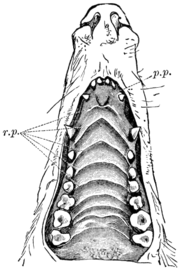be found at least traces of more cusps. Now in some of them we may be dealing with instances of a complete tooth change; the suppression, save for one tooth, which is found in Marsupials, was probably not developed in at least some of these early mammals. The simplicity may therefore have been preceded by complexity, and may have been merely an adaptation to an insectivorous diet.
Alimentary Canal.—The mouth of the Mammalia is remarkable for the fact that with a few exceptions, such as the Whales, there are thick and fleshy lips. The office of these is to seize the food. The roof of the mouth is formed by the "hard palate" in front, which covers over the maxillary and palatine regions. This region is often covered with raised ridges, which have a symmetrical disposition, and are particularly strong in Ruminant animals. They are much reduced in the Rodents, where the anterior part of the palate is ill-defined owing to the way in which its sides fade into the lateral surface of the face. It has been shown that these ridges, in the Cat at least, develop as separate papilliform outgrowths, and it has been suggested that these papillae, which later become united to form the ridges, are the last remnant of palatine teeth such as occur in lower vertebrates.

Fig. 40.—Palatal folds of the Raccoon (Procyon lotor). p.p, Papilla palatina; r.p, palatal folds. (From Wiedersheim's Structure of Man.)
The tongue is a well-developed organ, usually playing a double part. It acts as an organ of prehension, especially in such animals as the Giraffe and the Anteater, where it is long and protrusible beyond the mouth for a considerable distance. It also carries gustatory organs, which serve for the discrimination of the nature of the food. Beneath the tongue there may be a hardish plate, known as the sublingua. This is especially prominent in the Lemurs, where it projects as a horny structure below the tongue, and has an independent and free tip. It is supported in some of these animals by a cartilaginous
